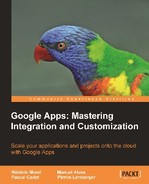Andro id is an operating system for mobile devices. It is comparable to Apple's iPhone OS and Microsoft's Windows Mobile. At the end of 2009, some 20 mobile phone models were already using the Android operating system.
Android is built on a simplified release of the Linux kernel, as is Chrome OS. The Java code of applications running on Android has to be compiled for a modified JVM, the Dalvik Virtual Machine.
The entire source code of Android is available under the Apache license, which allows any vendor to add proprietary extensions without having to give them back to the open-source community.
|
Handled by a database: SQLite | |
|---|---|
|
Connectivity |
GSM/EDGE, UTMS, WiFi, WiMAX. |
|
Messaging |
SMS, MMS. |
|
Audio and video |
H.263, H.264, MPEG-4 SP, AMR, AMR-WB, AAC, HE-AAC, MP3, MIDI, OGG Vorbis, WAV, JPEG, PNG, GIF, BMP. |
|
Catalog of applications |
Android Market : 40,000 applications, free or paid. |
|
Multi-touch |
Native. |
|
Bluetooth |
Native since release 2.0. |
Android's primary advantage compared to its direct competitors, iPhone OS and Windows Mobile, is its tight and advanced integration with Google Apps (see Part 2).
Android comes free of the hassle of configuration and setup: just a user name and password to access your Google Apps account and off you go!

Gmail user interface on Android: all features found in the regular Gmail (labels, starred items, and so on) can be found on Android
Considering the variety of mobile devices Android is likely to be installed on, it will be up to mobile vendors to port and upgrade Android to their own hardware. They will be free to upgrade or not when a new release is made available by Google. The business model of a vendor is based more on selling new peripherals than upgrading its existing installed base. Android upgrade policies thus differ from those of its direct competitor iPhone, whose vendor Apple supplies both the OS and the hardware.
With Software as a Service as the new IT paradigm, accessing the Information System from a user desktop or a mobile device has raised new security, performance, and user-interface requirements. This chapter has addressed the strategy Google has adopted to meet these new challenges. This strategy mainly relies on a joint effort pursued on the web browser front, with Chrome, a speedy browser, and on the operating system front, with Chrome OS, a speedy OS dedicated to quick and efficient operation of its lone application: Chrome.
